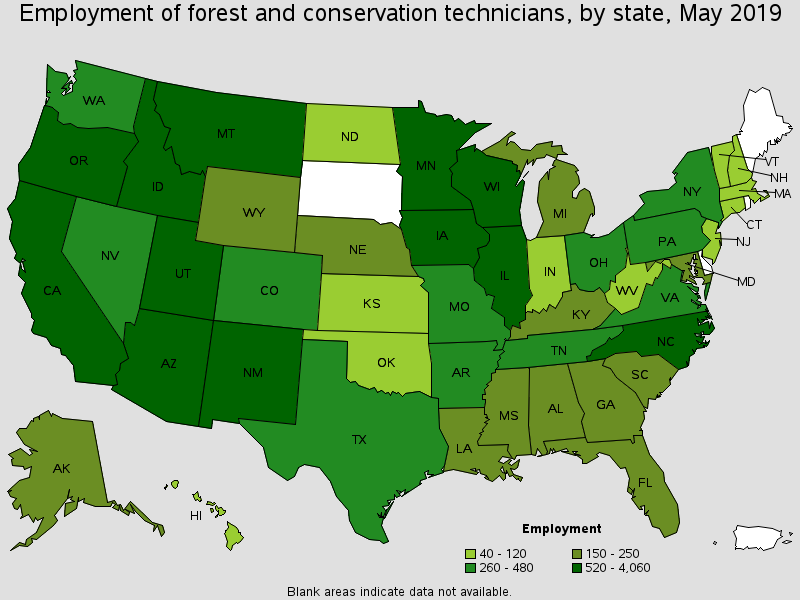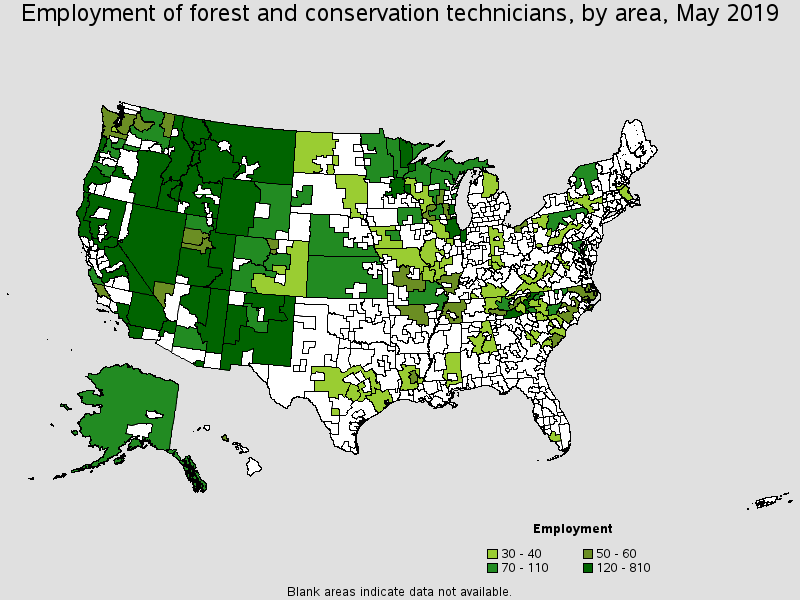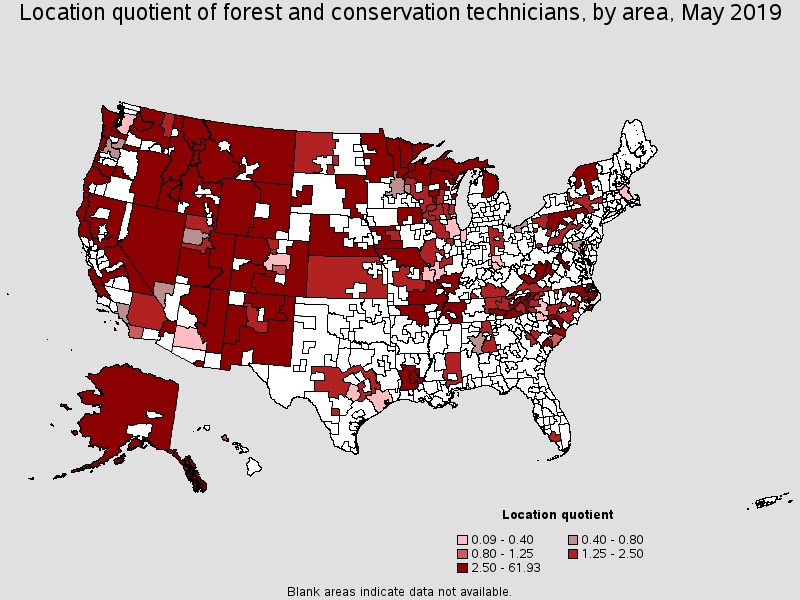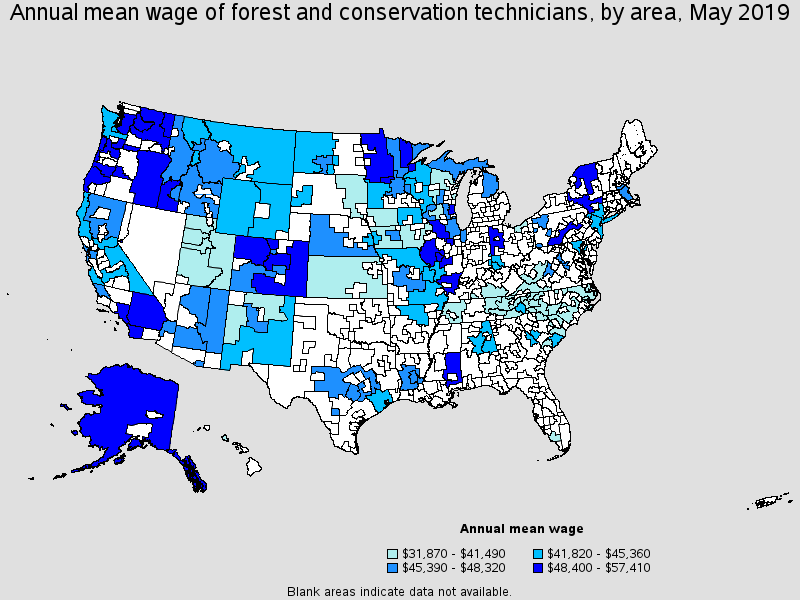An official website of the United States government
 United States Department of Labor
United States Department of Labor
Provide technical assistance regarding the conservation of soil, water, forests, or related natural resources. May compile data pertaining to size, content, condition, and other characteristics of forest tracts under the direction of foresters, or train and lead forest workers in forest propagation and fire prevention and suppression. May assist conservation scientists in managing, improving, and protecting rangelands and wildlife habitats. Excludes “Conservation Scientists” (19-1031) and “Foresters” (19-1032).
Employment estimate and mean wage estimates for this occupation:
| Employment (1) | Employment RSE (3) |
Mean hourly wage |
Mean annual wage (2) |
Wage RSE (3) |
|---|---|---|---|---|
| 19,060 | 1.6 % | $22.05 | $45,860 | 0.4 % |
Percentile wage estimates for this occupation:
| Percentile | 10% | 25% | 50% (Median) |
75% | 90% |
|---|---|---|---|---|---|
| Hourly Wage | $14.34 | $17.38 | $21.87 | $25.86 | $29.51 |
| Annual Wage (2) | $29,830 | $36,160 | $45,500 | $53,790 | $61,370 |
Industries with the highest published employment and wages for this occupation are provided. For a list of all industries with employment in this occupation, see the Create Customized Tables function.
Industries with the highest levels of employment in this occupation:
| Industry | Employment (1) | Percent of industry employment | Hourly mean wage | Annual mean wage (2) |
|---|---|---|---|---|
| Federal Executive Branch (OES Designation) | 9,930 | 0.49 | $23.32 | $48,500 |
| State Government, excluding schools and hospitals (OES Designation) | 4,550 | 0.21 | $19.67 | $40,920 |
| Local Government, excluding schools and hospitals (OES Designation) | 2,800 | 0.05 | $21.15 | $43,990 |
| Social Advocacy Organizations | 640 | 0.29 | $25.45 | $52,930 |
| Management, Scientific, and Technical Consulting Services | 350 | 0.02 | $21.61 | $44,960 |
Industries with the highest concentration of employment in this occupation:
| Industry | Employment (1) | Percent of industry employment | Hourly mean wage | Annual mean wage (2) |
|---|---|---|---|---|
| Federal Executive Branch (OES Designation) | 9,930 | 0.49 | $23.32 | $48,500 |
| Social Advocacy Organizations | 640 | 0.29 | $25.45 | $52,930 |
| State Government, excluding schools and hospitals (OES Designation) | 4,550 | 0.21 | $19.67 | $40,920 |
| Local Government, excluding schools and hospitals (OES Designation) | 2,800 | 0.05 | $21.15 | $43,990 |
| Museums, Historical Sites, and Similar Institutions | 60 | 0.03 | $15.40 | $32,040 |
Top paying industries for this occupation:
| Industry | Employment (1) | Percent of industry employment | Hourly mean wage | Annual mean wage (2) |
|---|---|---|---|---|
| Social Advocacy Organizations | 640 | 0.29 | $25.45 | $52,930 |
| Electric Power Generation, Transmission and Distribution | 50 | 0.01 | $24.22 | $50,370 |
| Federal Executive Branch (OES Designation) | 9,930 | 0.49 | $23.32 | $48,500 |
| Management, Scientific, and Technical Consulting Services | 350 | 0.02 | $21.61 | $44,960 |
| Colleges, Universities, and Professional Schools | 330 | 0.01 | $21.44 | $44,590 |
States and areas with the highest published employment, location quotients, and wages for this occupation are provided. For a list of all areas with employment in this occupation, see the Create Customized Tables function.

States with the highest employment level in this occupation:
| State | Employment (1) | Employment per thousand jobs | Location quotient (9) | Hourly mean wage | Annual mean wage (2) |
|---|---|---|---|---|---|
| California | 4,060 | 0.23 | 1.80 | $22.77 | $47,360 |
| Oregon | 1,120 | 0.59 | 4.52 | $24.61 | $51,180 |
| Montana | 860 | 1.83 | 14.12 | $21.87 | $45,490 |
| Idaho | 740 | 1.02 | 7.89 | $23.20 | $48,260 |
| Minnesota | 700 | 0.24 | 1.86 | $22.85 | $47,540 |

States with the highest concentration of jobs and location quotients in this occupation:
| State | Employment (1) | Employment per thousand jobs | Location quotient (9) | Hourly mean wage | Annual mean wage (2) |
|---|---|---|---|---|---|
| Montana | 860 | 1.83 | 14.12 | $21.87 | $45,490 |
| Idaho | 740 | 1.02 | 7.89 | $23.20 | $48,260 |
| Wyoming | 250 | 0.93 | 7.14 | $21.41 | $44,530 |
| New Mexico | 560 | 0.68 | 5.27 | $20.57 | $42,780 |
| Alaska | 200 | 0.62 | 4.79 | $25.74 | $53,550 |

Top paying States for this occupation:
| State | Employment (1) | Employment per thousand jobs | Location quotient (9) | Hourly mean wage | Annual mean wage (2) |
|---|---|---|---|---|---|
| Connecticut | 40 | 0.02 | 0.18 | $26.62 | $55,360 |
| Alaska | 200 | 0.62 | 4.79 | $25.74 | $53,550 |
| Pennsylvania | 300 | 0.05 | 0.39 | $24.69 | $51,360 |
| Oregon | 1,120 | 0.59 | 4.52 | $24.61 | $51,180 |
| New York | 360 | 0.04 | 0.29 | $24.32 | $50,590 |

Metropolitan areas with the highest employment level in this occupation:
| Metropolitan area | Employment (1) | Employment per thousand jobs | Location quotient (9) | Hourly mean wage | Annual mean wage (2) |
|---|---|---|---|---|---|
| Los Angeles-Long Beach-Anaheim, CA | 470 | 0.07 | 0.58 | $26.50 | $55,120 |
| Sacramento--Roseville--Arden-Arcade, CA | 410 | 0.41 | 3.14 | $20.30 | $42,210 |
| Riverside-San Bernardino-Ontario, CA | 360 | 0.23 | 1.81 | $24.41 | $50,780 |
| Chicago-Naperville-Elgin, IL-IN-WI | 230 | 0.05 | 0.38 | $22.26 | $46,300 |
| Flagstaff, AZ | 220 | 3.51 | 27.02 | $22.92 | $47,660 |
| Missoula, MT | 200 | 3.32 | 25.60 | $22.02 | $45,790 |
| San Diego-Carlsbad, CA | 200 | 0.13 | 1.01 | $23.27 | $48,400 |
| Milwaukee-Waukesha-West Allis, WI | 180 | 0.21 | 1.65 | $24.44 | $50,840 |
| Minneapolis-St. Paul-Bloomington, MN-WI | 160 | 0.08 | 0.63 | $22.13 | $46,030 |
| Fresno, CA | 160 | 0.40 | 3.11 | $21.32 | $44,350 |

Metropolitan areas with the highest concentration of jobs and location quotients in this occupation:
| Metropolitan area | Employment (1) | Employment per thousand jobs | Location quotient (9) | Hourly mean wage | Annual mean wage (2) |
|---|---|---|---|---|---|
| Flagstaff, AZ | 220 | 3.51 | 27.02 | $22.92 | $47,660 |
| Missoula, MT | 200 | 3.32 | 25.60 | $22.02 | $45,790 |
| Carson City, NV | 70 | 2.33 | 17.98 | $26.59 | $55,300 |
| Bend-Redmond, OR | 120 | 1.47 | 11.35 | $23.45 | $48,770 |
| Rapid City, SD | 80 | 1.28 | 9.87 | $20.98 | $43,640 |
| Wenatchee, WA | 60 | 1.20 | 9.26 | $24.61 | $51,190 |
| Duluth, MN-WI | 120 | 0.94 | 7.22 | $24.26 | $50,460 |
| Alexandria, LA | 50 | 0.82 | 6.33 | $21.87 | $45,490 |
| San Luis Obispo-Paso Robles-Arroyo Grande, CA | 50 | 0.45 | 3.46 | $22.73 | $47,280 |
| Eugene, OR | 70 | 0.44 | 3.38 | $24.73 | $51,430 |

Top paying metropolitan areas for this occupation:
| Metropolitan area | Employment (1) | Employment per thousand jobs | Location quotient (9) | Hourly mean wage | Annual mean wage (2) |
|---|---|---|---|---|---|
| Portland-Vancouver-Hillsboro, OR-WA | 100 | 0.08 | 0.62 | $27.60 | $57,410 |
| Carson City, NV | 70 | 2.33 | 17.98 | $26.59 | $55,300 |
| Los Angeles-Long Beach-Anaheim, CA | 470 | 0.07 | 0.58 | $26.50 | $55,120 |
| Seattle-Tacoma-Bellevue, WA | 60 | 0.03 | 0.24 | $26.22 | $54,540 |
| Fort Collins, CO | 50 | 0.30 | 2.34 | $25.52 | $53,080 |
| Spokane-Spokane Valley, WA | 60 | 0.26 | 2.01 | $24.91 | $51,800 |
| Eugene, OR | 70 | 0.44 | 3.38 | $24.73 | $51,430 |
| Boise City, ID | 140 | 0.43 | 3.30 | $24.72 | $51,420 |
| Wenatchee, WA | 60 | 1.20 | 9.26 | $24.61 | $51,190 |
| Milwaukee-Waukesha-West Allis, WI | 180 | 0.21 | 1.65 | $24.44 | $50,840 |
Nonmetropolitan areas with the highest employment in this occupation:
| Nonmetropolitan area | Employment (1) | Employment per thousand jobs | Location quotient (9) | Hourly mean wage | Annual mean wage (2) |
|---|---|---|---|---|---|
| North Valley-Northern Mountains Region of California nonmetropolitan area | 810 | 8.04 | 61.93 | $22.61 | $47,020 |
| Northwestern Idaho nonmetropolitan area | 350 | 5.13 | 39.53 | $22.58 | $46,970 |
| Eastern Sierra-Mother Lode Region of California nonmetropolitan area | 310 | 5.30 | 40.85 | $21.17 | $44,030 |
| West Montana nonmetropolitan area | 300 | 3.92 | 30.23 | $21.28 | $44,260 |
| North Coast Region of California nonmetropolitan area | 280 | 2.58 | 19.87 | $20.84 | $43,350 |
Nonmetropolitan areas with the highest concentration of jobs and location quotients in this occupation:
| Nonmetropolitan area | Employment (1) | Employment per thousand jobs | Location quotient (9) | Hourly mean wage | Annual mean wage (2) |
|---|---|---|---|---|---|
| North Valley-Northern Mountains Region of California nonmetropolitan area | 810 | 8.04 | 61.93 | $22.61 | $47,020 |
| Eastern Sierra-Mother Lode Region of California nonmetropolitan area | 310 | 5.30 | 40.85 | $21.17 | $44,030 |
| Northwestern Idaho nonmetropolitan area | 350 | 5.13 | 39.53 | $22.58 | $46,970 |
| West Montana nonmetropolitan area | 300 | 3.92 | 30.23 | $21.28 | $44,260 |
| Central Utah nonmetropolitan area | 190 | 3.86 | 29.75 | $19.70 | $40,970 |
Top paying nonmetropolitan areas for this occupation:
| Nonmetropolitan area | Employment (1) | Employment per thousand jobs | Location quotient (9) | Hourly mean wage | Annual mean wage (2) |
|---|---|---|---|---|---|
| Alaska nonmetropolitan area | 80 | 0.77 | 5.91 | $26.13 | $54,350 |
| Central East New York nonmetropolitan area | 30 | 0.20 | 1.50 | $25.40 | $52,830 |
| Eastern and Southern Colorado nonmetropolitan area | 40 | 0.55 | 4.27 | $25.01 | $52,030 |
| Eastern Oregon nonmetropolitan area | 260 | 3.65 | 28.11 | $24.79 | $51,570 |
| Southern Pennsylvania nonmetropolitan area | 30 | 0.17 | 1.30 | $24.64 | $51,260 |
These estimates are calculated with data collected from employers in all industry sectors, all metropolitan and nonmetropolitan areas, and all states and the District of Columbia. The top employment and wage figures are provided above. The complete list is available in the downloadable XLS files.
The percentile wage estimate is the value of a wage below which a certain percent of workers fall. The median wage is the 50th percentile wage estimate--50 percent of workers earn less than the median and 50 percent of workers earn more than the median. More about percentile wages.
(1) Estimates for detailed occupations do not sum to the totals because the totals include occupations not shown separately. Estimates do not include self-employed workers.
(2) Annual wages have been calculated by multiplying the hourly mean wage by a "year-round, full-time" hours figure of 2,080 hours; for those occupations where there is not an hourly wage published, the annual wage has been directly calculated from the reported survey data.
(3) The relative standard error (RSE) is a measure of the reliability of a survey statistic. The smaller the relative standard error, the more precise the estimate.
(9) The location quotient is the ratio of the area concentration of occupational employment to the national average concentration. A location quotient greater than one indicates the occupation has a higher share of employment than average, and a location quotient less than one indicates the occupation is less prevalent in the area than average.
Other OES estimates and related information:
May 2019 National Occupational Employment and Wage Estimates
May 2019 State Occupational Employment and Wage Estimates
May 2019 Metropolitan and Nonmetropolitan Area Occupational Employment and Wage Estimates
May 2019 National Industry-Specific Occupational Employment and Wage Estimates
Last Modified Date: July 6, 2020